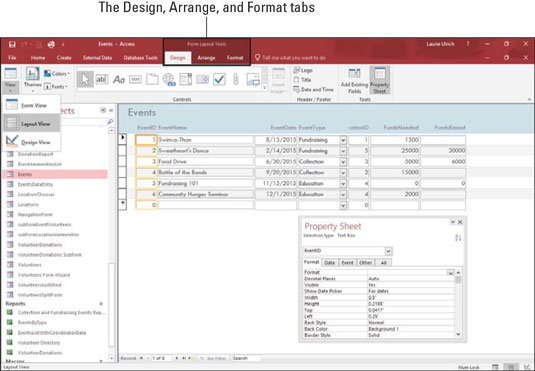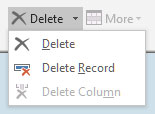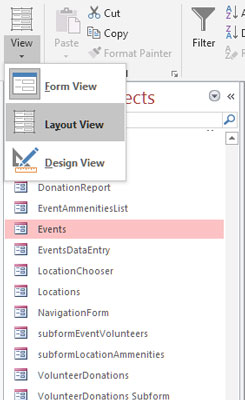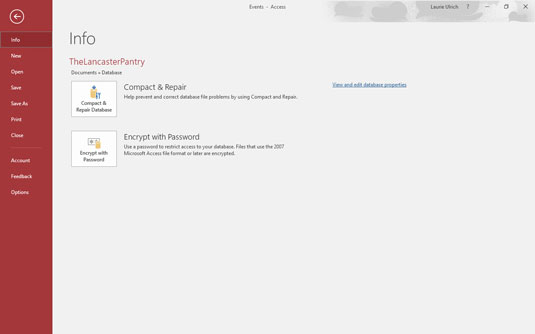 The main Ribbon tabs appear when you open a database.
The main Ribbon tabs appear when you open a database.When the Ribbon tabs first appear, many of their buttons are dimmed — because they don’t become available until you’re doing something that warrants their use. For example, if you haven’t opened any tables, forms, reports, or queries in your open database, the tools for editing or formatting your database will appear on the tabs, but they’ll be dimmed, which indicates that they’re unavailable. Tools for creating new components are available on the Create tab, but anything that works with existing data will be dimmed.
After you open a table, report, query, or form, the tools for that object become available. Displaying a form in Layout view, for example, adds the Form Layout Tools group of tabs to the main set of five tabs, as shown.
 The buttons relevant to what’s open and active in your database are available when you need them.
The buttons relevant to what’s open and active in your database are available when you need them.Clicking tabs in Access 2019
To move from one tab on the Ribbon to another, simply click the tab’s name. It’s easy to see which tab is currently open — as shown here, the Create tab stands out from all the other tabs, and you can see all its buttons. When you mouse over another tab, that tab brightens, too, but you don’t see its buttons until or unless you click the tab. You can easily tell the active tab (Create) from the inactive ones.
You can easily tell the active tab (Create) from the inactive ones.After you’ve created an object — say a table, by clicking Table on the Create tab — the Home tab is displayed, and a new label (Table Tools) appears above the context-sensitive Fields and Table tabs. See? Access knows what you need based on whatever you’ve just done within the application.
Using the Access 2019 buttons
Access buttons come in two varieties:- Buttons that do something when they’re clicked: Either opening a dialog box or wizard or performing some change or task in your open table, report, query, or form.
- Buttons that represent lists or menus of choices: This latter variety comes in two flavors of its own:
Drop-down list buttons are accompanied by a small, down-pointing triangle, appearing to the button’s right. When you click the triangle, a list of options appears, as shown.
 Click the triangle to the right of the button and make a choice.
Click the triangle to the right of the button and make a choice.- Some buttons have a down-pointing triangle at the bottom of the button (as shown here). Click the bottom half of the button (or on the triangle), and a menu appears.
 Menu buttons display a — surprise! — menu when clicked.
Menu buttons display a — surprise! — menu when clicked.The File tab and Quick Access tools
If you’re fresh from using a pre-2007 version of Office (XP and previous), you’ll be relieved to see a File tab. Office 2007 users lost that familiar word in that version’s interface, replaced then by an Office button, with no comforting word File on it. The word File came back in 2010, however, displaying Backstage view, for opening files, saving files, starting new files, printing, and customizing Access through the Options command. The File tab remains in Access 2019, and is shown here. Craving the File menu’s tools? Click the File tab to choose from a series of commands on the left.
Craving the File menu’s tools? Click the File tab to choose from a series of commands on the left.When you’re in a database and click the File tab, you’re taken to the Info display, showing information about the open database.
Where’s the Quick Access Toolbar? It appears while you’re in a database, but it disappears when you go to the File tab. No problem; to see it again, just click the Back button in the File panel, and you’re back to your database, with the Quick Access Toolbar in the uppermost left of the workspace. If you want to customize the Quick Access Toolbar, click the triangle at the right end of the toolbar. It offers a pop-up menu with several choices, from a list of commands you can add to the toolbar (such as New, Open, Email, or Quick Print — the ones already in use have a check mark next to them) to commands that allow you to Customize Quick Access Toolbar and Show Below the Ribbon.
Access panes, panels, and context-sensitive tools
Depending on what’s going on within the workspace — that is, what you’ve just done as you edit your table, report, query, or form, or which button you’ve clicked on one of the Ribbon tabs — Access offers relevant onscreen tools and panels. As an example of this context-sensitive feature, if you open a table and click the Report button on the Create tab (see the Reports section of the Create tab), not only does a report appear, but you also get new tabs — Design (shown here), Arrange, Format, and Page Setup, under the heading “Report Layout Tools”. Reporting-related tools appear precisely when they’re needed.
Reporting-related tools appear precisely when they’re needed.As you work with Access, you’ll get a feel for what’s going to appear when you do certain things. Things appear and disappear as you work because Access offers you just what you need for the task you’re performing or feature you’re using.





